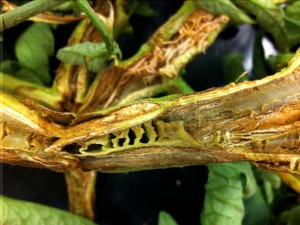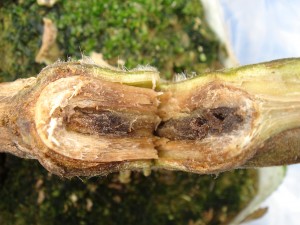What Is It? | Facts in Depth | For the Professional Diagnostician
M. L. Lewis & S. A. Miller
Tomato pith necrosis is caused by soil-borne species of Pseudomonas and Pectobacterium caratovorum. Incidence of pith necrosis is increasing in the Midwest. The disease is associated with cool nighttime temperatures and high humidity and fertility. Symptoms include yellowing of young leaves, top wilting and stem splitting. Split stems are often hollow or filled with adventitious roots. Avoiding excessive levels of nitrogen is a key management strategy.
Available Fact Sheets (pdf)
English: Pith Necrosis Fact Sheet
Español: Tomate Necrosis De Medula
Scientific Names
- Pseudomonas corrugata
- Pseudomonas cichorii
- Pseudomonas viridiflava
- Pseudomonas mediterranea
- Pseudomonas marginalis
- Pectobacterium carotovorum (previously Erwinia carotovora)
Host Crops
- Tomato, Field
- Tomato, Greenhouse
- Tomato, High Tunnels
- Bell Pepper






Images of Tomato Pith Necrosis symptoms on tomato plants courtesy of Dr. Margaret McGrath, Cornell University (Top Left, Center, Right; Bottom Left, Center).
